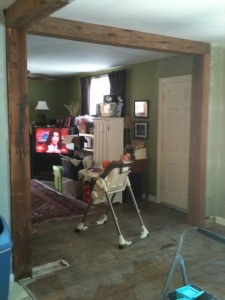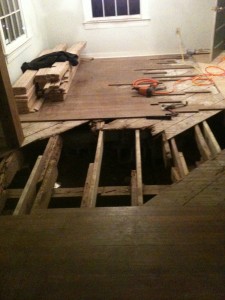Here’s the scene – myself, my lovely wife Rebecca, my 5 year old daughter and twin two year olds living in 700 square feet of space surrounded by dirt, dust, roofing nails and exposed wiring. If this sounds like a bad idea to you, you would be right. I know from personal experience having just “completed” my own renovation of my own home.
My father Al taught me a long time ago that keeping a client happy through this experience takes an awful lot more than just a set of great blue prints. Basically, we make it a point to care, to listen and to help in any way we can. As an architect, I have helped guide countless families through new construction and renovations. I thought I understood, and I did to some degree. But I now understand fully the emotions and impact a construction project can have on a family.
What I learned renovating my own home
1. Start with what you really want
This sounds ridiculously simple. When designing a renovating or a home, start with what you want your home to look and feel like. All too often, people start with what they think they have to do, rather than what they want to do. Here’s the truth – when you begin the process with limitations, you are not going to be happy with the results.
Rebecca and I started with everything we wanted before realizing we couldn’t afford it. Then we took a wrong turn and redesigned the renovation to what we thought we had to do, and ended up with a design that made us miserable. The limitations we put on ourselves found their way into the plans and the entire project became less about building a home my family and I could love for the next 15 years into a project of necessity and practicality. We lived with this reality for a couple of weeks before realizing we just weren’t willing to invest this much money into something that made us so unhappy. We went back to what we really wanted, met again with our contractors and we made it work.

If you want a gold toilet, by all means go for it.
2. Don’t live in your home during renovation (if you can help it).
I learned this one the hard way. There are a few things I learned about renovations that I wish I hadn’t. For one thing, it is dirtier than you can possible imagine. However dirty you think it’s going to be, quadruple it and then throw some mud on top of that. Second, when you’re living with the construction every day, time nearly stops and every day feels like a week. If you only visit the site once a week, you notice big chunks of progress. If you’re living in the space, you don’g get that satisfaction. The emotional toll this takes on you is real. It’s hard to live with. So, make sure everyone in your home is 100% committed to staying in the home and doing whatever it takes to keep the peace.
Also, if you have two year old twins and a five year old, living in 700 square feet of squalor with no kitchen and just one bathroom is a really, really bad idea.

Children and construction sites don’t usually go well together.
3. Have a backup plan
This is especially true when you’re on a budget. Labor, materials and expertise will all cost more than you expect. So have a backup plan for your want list. If you can’t afford the custom window, have a backup option that is acceptable to you. If you can’t squeeze into your budget that particular slab of granite you really wanted, make sure you have another more reasonably priced option picked out long before you have to make that decision. But be sure that, no matter what your backup plan is, it is something you are willing to live with for the long term. See #5 on this list – don’t be satisfied until you’re satisfied, even when you have to go to your backup plan.
4. Fix your existing home first.
Chances are your home that you are renovating has problems and has repair needs. Before budgeting for your renovation, fix your existing home so you won’t end up having to steal resources from your addition. Fix the cracked windows, repair the buckled floor, finally address that plumbing problem that has plaqued your home for years. Don’t proceed to build a brand new renovation when the rest of your home is in disrepair. You will undercut the value of your home and your renovation investment will be significantly hampered. And if you don’t fix your existing home before you spend your budget on your renovation, chances are you never will.
But be realistic. If the goal is an addition, use your backup plan to prevent it from being just a basic renovation. Additions usually reveal the source of what’s wrong with your house and will prove to be more expensive than just a patch. So be prepared

Renovations can get messy.
5. Have an advocate, and don’t be satisfied until you’re satisfied.
It’s intimidating when you have contractors, builders and laborers all telling you something simply cannot be done and you have to accept a less-satisfying option. I had drawn a breakfast room that extended out from the kitchen as a seamless addition. But contractors told me we would have to tie into an exposed beam to make the addition. Having the addition appear seamless was an important design element to me, so I wouldn’t accept that answer. I listened carefully to what they each had to say, revisited the plans and came up with a very simple but different solution that made my wife and I happy. The point is this – your builders are there to get the job done. Someone else has to be there to ensure the job gets done how you want it to get done. If you aren’t qualified to do that, find someone who is. You get one shot at a new construction or renovation. Make sure it’s done how you want it done.
In a construction project, everyone needs an advocate – someone knowledgeable to help push for what you truly want. Interestingly, even though I am an architect, it was really my wife Rebecca who drove this home for me. She simply would not accept what she was not satisfied with. She stayed on me during the drawing and planning phase to make sure I didn’t undercut our own vision for our home. During construction, it was Rebecca who refused to accept anything less than what the two of us truly wanted. I am more accustomed to working with homes on a larger scale. Rebecca helped me to better understand how every inch matters on projects of this size. With a small home like ours, moving something even just one inch has a huge impact on the overall design.



